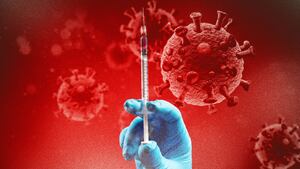Even though New York has one of the strictest mask mandates in the country, and one-third of the population has received at least one dose of the vaccine, COVID-19 infection rates are rising faster than any other state in the U.S.—and public health experts aren’t completely sure what’s behind the spike in new cases.
“The reality is that no one knows exactly why,” Dr. Irwin Redlener, a New York epidemiologist specializing in pandemic response, told The Daily Beast. “There are a lot of factors in New York that have to do with population density, lots of people who are in marginalized populations or living in poverty, and all of these factors tend to exacerbate spread and reduce access to vaccines. But one of my colleagues pointed out that this is not dissimilar to places like Detroit, where they are not seeing a surge.”
After nearly three months on a downward trajectory, new coronavirus cases rose 64 percent in New York last week. State officials reported 67,963 new cases for the seven-day period, an increase of 26,557 from the previous week. This gives New York the dubious distinction of being the state in which COVID is spreading fastest on a per-person basis, according to a USA Today data analysis, and the biggest increase has been in New York City. About 55 New York City residents have died from COVID each day over the past two weeks, per New York magazine, higher than it was at any point from last August to the beginning of December.
At the same time, embattled New York Gov. Andrew Cuomo continues to relax COVID restrictions on indoor dining, recently allowing restaurants to operate at 50 percent capacity. Indoor fitness classes reopened statewide on Mar. 22 at 33 percent capacity, Yankee Stadium and Citi Field will soon open at 20 percent capacity, and New Yorkers are once again permitted to go to movie theaters (25 percent in New York City) and billiard halls (35 percent in the city, 50 percent elsewhere in the state).
“We’re not doing enough genomic surveillance,” said Redlener. “It may be that we’re dealing with some yet unidentified strains in New York. Unfortunately, the conclusion is we don't know why the New York Metro area is being hit. We don't have a lot of information that really explains this uniqueness. It’s a mystery that will eventually be unraveled—but not yet.”
The acceleration in new COVID cases also puzzles Lawrence Gostin, a public health law professor at Georgetown University who is affiliated with the World Health Organization. Sometimes, the reasons can be obvious, such as an influx of Spring Breakers gathering together at one time, he said. However, New York City isn’t a Spring Break destination. There may be other factors at play, according to Gostin, who speculated about three possibilities.
First, people have a tremendous amount of “pandemic fatigue,” and are itching to go out again. And it’s far easier to get COVID while seeing friends in a restaurant or bar than it is sitting six feet away from them in Central Park.
Second, Gostin pointed to the population density of New York City as a potential reason for the uptick in new cases.
“There are just a lot of people packed together,” he said. “Thirdly, I think the U.K. variant could be an explanation because it’s so much more transmissible than the original virus and that's also a contributor.”
The U.K. variant, or B117, is the main culprit behind any surge right now, believes Dr. Emily Landon, an infectious disease expert at the University of Chicago Medical Center. It’s the most aggressive and most dangerous, and leads to more deaths than the original permutation of the virus, she said.
“Every cough and sneeze from a person who has B117 has more virus in it than the others, and it takes fewer viral particles to make you sick,” Landon told The Daily Beast. “So it’s a double whammy. I don't think people understand that, really.”
Landon doesn’t see the New York surge—as well as a midwestern version of it happening now in her home state of Illinois—as much of a surprise.
“We knew for a while that the variants were going to begin to spread more rapidly, and our vaccine effort wasn't going to outpace that,” she said. “It’s a little bit like the tortoise and the hare: right now, the variants are the hare and the vaccines are the tortoise.”
B117 is the COVID strain that’s pushing hospitalization numbers up for younger people across the country right now, said Landon. And while younger people tend not to get as sick as those who are older, she pointed out that even mild cases of COVID can lead to things like long-term organ damage.
Children with mild cases of COVID can also act as vectors, spreading it to family members, teachers, and others with whom they may come into close contact, according to Ryan Marino, a Cleveland, Ohio ER doctor who has treated patients who refused to believe COVID was real. This could also be contributing to the rise in COVID infections in places where schools have reopened for in-person learning, such as New York City.
Ignoring this “big part of the equation” is unwise, Marino said, adding that kids are “definitely catching the virus and spreading the virus.”
“It’s heartbreaking that we haven’t learned from 500,000 preventable deaths, and more that could be prevented if people didn’t have a need to be wall-to-wall bodies on Miami Beach,” he told The Daily Beast. “We really are very close to having some degree of control here, so it does feel kind of exasperating to see people kind of throwing caution to the wind when we’re in the home stretch.”
We’re close to the light at the end of the tunnel, said Gostin.
“Just hold on for another four to six weeks,” he said. “Then there are going to be enough people vaccinated to break the chains of transmission, and by spring and summer we’re going to see a significant drop in cases and a truly dramatic drop in hospitalizations and deaths.”








